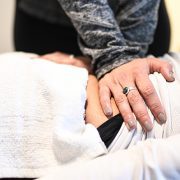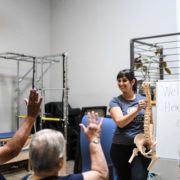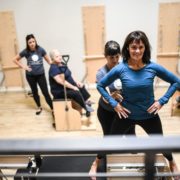Tight knots in your muscles? Do’s and Don’ts
At one point or another, or perhaps even this very second, you’ve experienced tight knots in your muscles.
They are annoying, nagging, uncomfortable, and quite often painful.
The most common area to feel these knots is in your upper traps (the triangle shaped area between your shoulder blades and base of your neck). But other areas of your body that love to get knotted up include your mid and lower back, your hips and butt, the front and sides of your thighs, and the back of your lower legs.
The first thing people think to do when experiencing these tight knots or muscle spasms is to get a massage or try rolling them out with a foam roller. Lately, theraguns seem to be the craze. These devices look like power drills and use percussive therapy to reduce pain and relieve tightness in the affected area. In our office, for really stubborn and painful knots, we use something called dry needling, which is where you take a tiny acupuncture needle and insert it into the tight knot to bring blood flow to the area and release tension.
These are all great options, and for the most part, I put them in the category of “Do’s” when it comes to getting rid of tight knots in your muscles.
Sounds pretty simple, right? Well, not so fast. Not all muscle knots are meant to be released.
“Don’t” aggressively release a tight knot in your muscle until you know why it’s there.
Sometimes, muscle knots form as a critical compensatory strategy. If released too quickly, they can set off an array of problems. I was just talking to my massage therapist about this, because she’s seen it happen to her own clients. Occasionally, she’ll work her magic to get rid of tight muscle knots only to find the client feels worse after the session. This can happen when the tight knot was there to compensate for a weak muscle elsewhere.
Let me explain.
Muscles are connected via highly innervated tissue called fascia. It looks like a spider web and one of its main functions is to connect organs and muscles together. Fascia is still being studied, but one of the theories is that if one muscle group in that fascial line is not doing its job, a different muscle will work extra hard in its place to take up the slack. Eventually, that muscle will get exhausted and tighten up into a knot, because it’s doing more work than it was designed to.
If you release a knot that is “holding the line” together, you’re asking for trouble.
In this example, what I’ve found is that the passive methods of releasing muscles (those I mentioned earlier) aren’t very effective at helping you get rid of the problem. You might actually end up feeling worse or having pain elsewhere. If your tight muscle knot is there to act as a survival mechanism, it’s going to take a more comprehensive and total body approach to resolve it. You’ll need to figure out which muscle or muscles the tight knot is compensating for and address them at the same time you work to release the tight knot. You can keep getting your weekly massage, but you’ve got to pair it up with correctly prescribed exercises.
To summarize, DO figure out WHY you have a tight knot in your muscle first.
Is it there because you overworked it in the gym? Maybe you’ve taken on a new project at home that is repetitive in nature?
If these are the reasons you’ve got tight knots in your muscles, then DO release them. You’ll likely feel better. And then correct the movement patterns, so the knot doesn’t come back.
If you feel worse after releasing the tight knots in your muscles, or the knot keeps coming back, then the problem likely involves more than just that muscle and you need a more comprehensive approach to get rid of it.
DON’T continue to release it over and over.
If you’re suffering from stubborn knots that won’t go away, get assessed by movement experts like us who can diagnose your problem accurately and help you get rid of the tight knots in your muscles for good.
Dr. Carrie Jose – back pain specialist and Pilates expert – owns CJ Physical Therapy & Pilates in Portsmouth, NH











